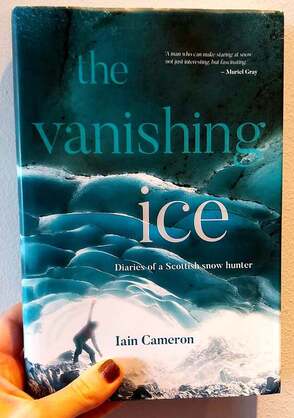
This landscape is not static. It is in a constant state of change. Imperceptible differences accumulate over hundreds and thousands of years. Our own fleeting time on the planet allows us but a brief glimpse of this relentless process which will, ultimately, turn the hill back into the dust it was fashioned with.
I’ve followed Iain Cameron on Twitter for a while now and always really enjoy his updates on Scotland’s remaining snow patches, so I was excited to hear he had a book coming out. In The Vanishing Ice, Iain explores the history of UK snow patches, recounts some days he’s spent trying to find his way to these remote and inaccessible places, and discusses the significance of the recent summers where every snow patch has melted.
I found this to be a really fascinating read. Iain talks about his childhood interest in snow patches and how that never left him – such an inspiring example of the importance of letting children follow their passions, however niche these might seem! He searches through a range of historical accounts, covering an impressive amount of research trying to track the existence of these snow patches through recent history. It’s amazing how much other people have recorded, sometimes inadvertently.
The idea of these snow patches as a capsule of the past is really intriguing – a tiny piece of history clinging on into the future. Iain finds himself to be the first person (certainly at least in recent history) standing on the patch of ground that existed beneath a snow patch that has finally vanished. There’s certainly something really captivating about the chance to glimpse something that’s been hidden for so long, even if here it feels a bit like a dirty secret, catching sight of something that should have stayed hidden. That is, of course, the crux of some of the current interest in snow patches: the melting that now occurs regularly hasn’t been seen for decades. Climate change is stealing the snow which should be clinging on through the summer. Iain tries to avoid discussing this in too much depth, but its touch on these mountains is unmissable. The strongest chapters are where Iain recounts some of his trips into the mountains, either solo or with others. The writing is vivid, and it would be difficult for Iain to overstate the dangers of the weather and terrain. I had no idea checking on these snow patches involved such a high level of risk! Iain’s knowledge of these remote areas must be second to none, and it’s interesting watching his mental process as he juggles multiple routes in his head, knowing how and when it’s necessary to head for the riskier options. He gets into a slight tangent about social media and necessary hill kit towards the end of the book, but I found the details of his decision making process to be the clearest example of the importance of understanding the environment you’re planning to be out in – the kind of intricate knowledge that can’t be short-cut. Iain’s enthusiasm for the mountains and the snow is unrelenting, and it’s certainly left me daydreaming about those long winter days in the hills… (With thanks to the lovely folk at Vertebrate Publishing for a free copy in exchange for an honest review.)
0 Comments
Leave a Reply. |
book REVIEWSPredominantly climbing/outdoors literature, mountaineering history and nature writing. Archives
July 2023
Categories
All
|
 RSS Feed
RSS Feed


